Master-Worker
Also known as
- Master-Slave
- Controller-Worker
Intent
The Master-Worker pattern is designed to perform parallel computations through the division of labor between coordinating 'master' processes and multiple 'worker' processes.
Explanation
Real World Example
Imagine a large restaurant kitchen where the head chef acts as the "master" and the line cooks serve as "workers." The head chef receives the orders from the dining area and breaks down each order into specific tasks, such as grilling meat, preparing salads, and cooking desserts. Each task is assigned to a different line cook based on their expertise and current workload. The line cooks work in parallel to prepare their portion of the order, while the head chef oversees the process, ensuring everything is prepared correctly and timely. Once each component of the order is ready, the head chef gathers all parts, gives them a final check, and then plates the dishes for service. This kitchen operation mimics the Master-Worker pattern by distributing and managing tasks to optimize efficiency and output.
In Plain Words
The Master-Worker pattern involves a master process delegating tasks to multiple worker processes, which execute them concurrently and report back, optimizing parallel task processing and throughput.
Wikipedia Says
Master–slave is a model of asymmetric communication or control where one device or process (the master) controls one or more other devices or processes (the slaves) and serves as their communication hub. In some systems, a master is selected from a group of eligible devices, with the other devices acting in the role of slaves.
Programmatic Example
The Master-Worker pattern is a design pattern that is used for parallel processing. It involves a master component that divides a task into subtasks and distributes them among worker components. The workers process the subtasks independently and return the results to the master, which then aggregates the results to form the final output.
// The MasterWorker class acts as the main entry point for the Master-Worker system.
public class MasterWorker {
private Master master;
public MasterWorker(Master master) {
this.master = master;
}
public Result getResult(Input input) {
return master.computeResult(input);
}
}
In this code, the MasterWorker class is initialized with a Master object. The getResult method is used to start the computation process.
// The Master class is responsible for dividing the work among the workers.
public abstract class Master {
protected List<Worker> workers;
public Master(List<Worker> workers) {
this.workers = workers;
}
public abstract Result computeResult(Input input);
}
The Master class has a list of Worker objects. The computeResult method is abstract and should be implemented in a subclass to define how the work is divided and how the results are aggregated.
// The Worker class is responsible for performing the actual computation.
public abstract class Worker extends Thread {
protected Input input;
public void setInput(Input input) {
this.input = input;
}
public abstract Result compute();
}
The Worker class extends Thread, allowing it to perform computations in parallel. The compute method is abstract and should be implemented in a subclass to define the actual computation logic.
// The Input and Result classes are used to encapsulate the input data and the result data.
public abstract class Input<T> {
public final T data;
public Input(T data) {
this.data = data;
}
public abstract List<Input<T>> divideData(int num);
}
public abstract class Result<T> {
public final T data;
public Result(T data) {
this.data = data;
}
}
The Input class has a divideData method that is used to divide the input data into subtasks. The Result class simply encapsulates the result data.
Class diagram

Applicability
- Suitable for scenarios where a task can be decomposed into smaller, independent tasks.
- Useful in applications requiring concurrent execution to enhance performance.
- Applicable in distributed computing where tasks need to be processed by multiple processors or machines.
Known Uses
- Implemented in distributed systems to manage tasks across different computing resources.
- Used in server architectures to process multiple client requests simultaneously.
- Utilized in scientific computation frameworks where large datasets require parallel processing.
Consequences
Benefits:
- Enhances performance by parallelizing tasks.
- Increases responsiveness of systems handling large volumes of requests.
- Provides a clear separation of concerns between task coordination and task execution, simplifying design.
Trade-offs:
- Complexity in managing synchronization and state consistency between master and workers.
- Overhead of managing communication between master and workers, especially in distributed environments.
Related Patterns
- Task Parallelism and Data Parallelism: Master-Worker utilizes these patterns to divide work into tasks or data segments.
- Producer-Consumer: Similar in structure but focuses on balancing production and consumption rates; Master-Worker is more about task distribution and aggregation.
- Pipeline: Both organize processing steps but Pipeline arranges them linearly whereas Master-Worker may not impose such a sequence.